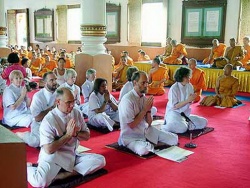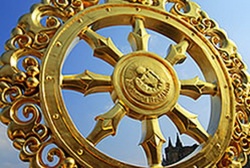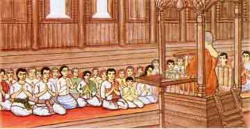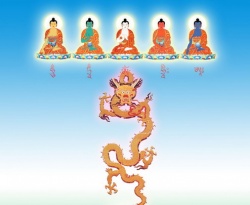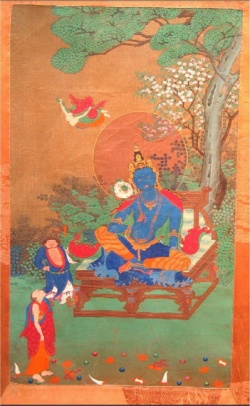Gnosticism
Gnosticism (from gnostikos, "learned", from Greek: γνῶσις gnōsis, Knowledge; Arabic: الغنوصية) is the dualistic belief that the material World should be shunned and the Spiritual World should be embraced. Gnostic ideas influenced many ancient religions which teach that gnosis (variously interpreted as Enlightenment, salvation, emancipation or 'oneness with God') may be reached by practicing philanthropy to the point of personal poverty, sexual abstinence (as far as possible for hearers, total for initiates) and diligently searching for Wisdom by helping others.
Gnosticism was primarily defined in a Christian context. Some scholars have claimed that gnosticism predated [[Wikipedia:Christianity|Christianity]]. Such discussions have included pre-Christian religious beliefs and Spiritual practices argued to be common to early [[Wikipedia:Christianity|Christianity]], Hellenistic Judaism, Greco-Roman mystery religions, Zoroastrianism (especially Zurvanism), and Neoplatonism. The discussion of gnosticism changed radically with the discovery of the Nag Hammadi library and led to revision of older assumptions.
Terms and concepts
Abraxas/Abrasax
Engraving from an Abraxas stone.
The Egyptian Gnostic Basilideans referred to a figure called Abraxas who was at the head of 365 Spiritual beings (Irenaeus, Adversus Haereses, I.24); it is unclear what to make of Irenaeus' use of the term "Archon", which may simply mean "ruler" in this context. The role and function of Abraxas for Basilideans is not clear.
The word Abraxas was engraved on certain antique gemstones, called on that account Abraxas stones, which may have been used as amulets or charms by Gnostic groups. In popular culture, Abraxas is sometimes considered the name of a God who incorporated both Good and Evil (God and Demiurge) in one entity, and therefore representing the monotheistic God, singular, but (unlike, for example, the Christian God) not omni-benevolent. (See Hesse's Demian, and Jung's Seven Sermons to the Dead.) Opinions abound on Abraxas, who in recent centuries has been claimed to be both an Egyptian God and a demon, sometimes even being associated with the dual nature of Satan/Lucifer.
The above Information relates to interpretations of ancient amulets and to reports of Christian Heresy hunters which are not always clear.
Actual ancient Gnostic texts from the Nag Hammadi Library, such as the Coptic Gospel of the Egyptians, refer to Abraxas as an Aeon dwelling with Sophia and other Aeons of the Spiritual Fullness in the Light of the luminary Eleleth. In several texts, the luminary Eleleth is the last of the luminaries (Spiritual Lights) that come forward, and it is the Aeon Sophia, associated with Eleleth, who encounters darkness and becomes involved in the chain of events that leads to the Demiurge and Archon's rule of this World, and the salvage effort that ensues. As such, the role of Aeons of Eleleth, including Abrasax, Sophia, and others, pertains to this outer border of the Divine Fullness that encounters the Ignorance of the World of Lack and interacts to rectify the error of Ignorance in the World of materiality.
Words like or similar to Abraxas or Abrasax also appear in the Greek Magical Papyri. There are similarities and differences between such figures in reports about Basiledes' teaching, in the larger magical traditions of the Graeco-Roman World, in the classic ancient Gnostic texts such as the Gospel of the Egyptians, and in later magical and esoteric writings.
The Swiss psychologist Carl Jung wrote a short Gnostic treatise in 1916 called Seven Sermons to the Dead, which called Abraxas a God higher than the Christian God and Devil, that combines all opposites into one Being.
Aeon
In many Gnostic systems, the æons are the various emanations of the superior God, who is also known by such names as the One, the Monad, Aion teleos (Greek: "The Complete Æon"), Bythos (Greek: Βυθος, 'Depth' or 'profundity'), Proarkhe (Greek: προαρχη, "Before the Beginning'), E Arkhe (Greek: ἡ ἀρχή, 'The Beginning'), Ennoia (Greek: "Thought") of the Light or Sige (Greek: Σιγη, "Silence"). From this first being, also an æon, a series of different emanations occur, beginning in certain Gnostic texts with the hermaphroditic Barbelo, from which successive pairs of aeons emanate, often in male-female pairings called syzygies; the numbers of these pairings varied from text to text, though some identify their number as being thirty. The aeons as a totality constitute the pleroma, the "region of Light". The lowest regions of the pleroma are closest to the darkness; that is, the physical World.
Two of the most commonly paired æons were Jesus and Sophia (Greek: "Wisdom"); the latter refers to Jesus as her "consort" in A Valentinian Exposition. Sophia, emanating without her partner, resulting in the production of the Demiurge (Greek: lit. "public builder"), who is also referred to as Yaldabaoth and variations thereof in some Gnostic texts. This creature is concealed outside the Pleroma; in isolation, and Thinking itself alone, it creates materiality and a host of co-actors, referred to as archons. The demiurge is responsible for the creation of mankind; trapping elements of the Pleroma stolen from Sophia inside human bodies. In response, the Godhead emanates two savior æons, Christ and the Holy Spirit; Christ then embodies itself in the Form of Jesus, in order to be able to teach man how to achieve gnosis, by which they may return to the Pleroma.
Archon
In late antiquity some variants of Gnosticism used the term Archon to refer to several servants of the Demiurge. In this context they may be seen as having the roles of the angels and demons of the Old Testament.
According to Origen's Contra Celsum, a sect called the Ophites posited the existence of seven archons, beginning with Iadabaoth or Ialdabaoth, who created the six that follow: Iao, Sabaoth, Adonaios, Elaios, Astaphanos and Horaios. Similarly to the Mithraic Kronos and Vedic Narasimha, a Form of Vishnu, Ialdabaoth had a head of a lion.
Demiurge
A lion-faced deity found on a Gnostic gem in Bernard de Montfaucon's l'antiquité expliquée et représentée en figures may be a depiction of the Demiurge; however, cf. Mithraic Zervan Akarana
The term Demiurge derives from the Latinized Form of the Greek term dēmiourgos, δημιουργός (literally "public or skilled worker"), and refers to an entity responsible for the creation of the physical Universe and the physical aspect of humanity. The term dēmiourgos occurs in a number of other religious and philosophical systems, most notably Platonism. Moral judgements of the demiurge vary from group to group within the broad category of Gnosticism — such judgements usually correspond to each group's Judgement of the status of materiality as being inherently Evil, or else merely flawed and as good as its passive constituent matter will allow. In Gnosticism the Demiurge, creator of the material World, was not God but the Archon.
As Plato does, Gnosticism presents a distinction between a supranatural, unknowable reality and the sensible materiality of which the demiurge is creator. However, in contrast to Plato, several systems of Gnostic Thought present the Demiurge as antagonistic to the Supreme God: his act of creation either in Unconscious and fundamentally flawed imitation of the divine model, or else formed with the malevolent intention of entrapping aspects of the divine in materiality. Thus, in such systems, the Demiurge acts as a solution to the problem of Evil. In the Apocryphon of John (several versions of which are found in the Nag Hammadi library), the Demiurge has the name "Yaltabaoth", and proclaims himself as God:
"Now the archon who is weak has three names. The first name is Yaltabaoth, the second is Saklas, and the third is Samael. And he is impious in his arrogance which is in him. For he said, 'I am God and there is no other God beside me,' for he is ignorant of his strength, the place from which he had come."
"Samael", in the Judeo-Christian tradition, refers to the Evil angel of Death, and corresponds to the Christian demon of that name, one second only to Satan. Literally, it can mean "blind God" or "God of the blind" in Aramaic (Syriac sæmʻa-ʼel); another alternative title is "Saklas", Aramaic for "fool" (Syriac sækla "the foolish one").
Gnostic myth recounts that Sophia (Greek, literally meaning "Wisdom"), the Demiurge's mother and a partial aspect of the divine Pleroma or "Fullness", desired to create something apart from the divine totality, and without the receipt of divine assent. In this abortive act of separate creation, she gave birth to the monstrous Demiurge and, being ashamed of her deed, she wrapped him in a cloud and created a throne for him within it. The Demiurge, isolated, did not behold his mother, nor anyone else, and thus concluded that only he himself existed, being ignorant of the superior levels of reality that were his birthplace.
The Gnostic myths describing these events are full of intricate nuances portraying the declination of aspects of the divine into human Form; this process occurs through the agency of the Demiurge who, having stolen a portion of Power from his mother, sets about a work of creation in Unconscious imitation of the superior Pleromatic realm. Thus Sophia's Power becomes enclosed within the material forms of humanity, themselves entrapped within the material Universe: the goal of Gnostic movements was typically the Awakening of this spark, which permitted a return by the subject to the superior, non-material realities which were its primal source. (See Sethian Gnosticism.)
Gnosis
The word "Gnosticism" is a modern construction, though based on an antiquated linguistic expression: it comes from the Greek word meaning "Knowledge", gnosis (γνῶσις). However, gnosis itself refers to a very specialised Form of Knowledge, deriving both from the exact meaning of the original Greek term and its usage in Platonist philosophy.
Ancient Greek was capable of discerning between several different forms of knowing. These different forms may be described in English as being propositional Knowledge, indicative of Knowledge acquired indirectly through the reports of others or otherwise by inference (such as "I know of George Bush" or "I know Berlin is in Germany"), and empirical Knowledge acquired by direct participation or acquaintance (such as "I know George Bush personally" or "I know Berlin, having visited").
Gnosis (γνῶσις) refers to Knowledge of the second kind. Therefore, in a religious context, to be "Gnostic" should be understood as being reliant not on Knowledge in a general sense, but as being specially receptive to Mystical or esoteric experiences of direct participation with the divine. Indeed, in most Gnostic systems the sufficient cause of salvation is this "Knowledge of" ("acquaintance with") the divine. This is commonly identified with a process of inward "knowing" or self-exploration, comparable to that encouraged by Plotinus (c. 205–270 AD). This is what helps separate Gnosticism from proto-orthodox views, where the orthodox views are considered to be superficial. The inadequate take then requires a correct Form of interpretation. With "gnosis" comes a fuller Insight that is considered to be more Spiritual. Greater recognition of the deeper Spiritual meanings of doctrines, scriptures, and Rituals are obtained with this Insight. However, as may be seen, the term "gnostic" also had precedent usage in several ancient philosophical traditions, which must also be weighed in considering the very subtle implications of its appellation to a set of ancient religious groups.
Monad
In many Gnostic systems (and heresiologies), God is known as the Monad, the One, The Absolute, Aion teleos (The Perfect Æon), Bythos (Depth or Profundity, Βυθος), Proarkhe (Before the Beginning, προαρχη), and E Arkhe (The Beginning, η αρχη). God is the high source of the pleroma, the region of Light. The various emanations of God are called æons.
Within certain variations of Gnosticism, especially those inspired by Monoimus, the Monad was the highest God which created lesser gods, or elements (similar to æons).
According to Hippolytus, this view was inspired by the Pythagoreans, who called the first thing that came into existence the Monad, which begat the dyad, which begat the numbers, which begat the point, begetting lines, etc. This was also clarified in the writings of Plato, Aristotle and Plotinus. This teaching being largely Neopythagorean via Numenius as well.
This Monad is the Spiritual source of everything which emanates the pleroma, and could be contrasted to the dark Demiurge (Yaldabaoth) that controls matter.
The Sethian cosmogony as most famously contained in the Apocryphon ("Secret book") of John describes an unknown God, very similar to the orthodox apophatic theology, although very different from the orthodox credal teachings that there is one such God who is identified also as creator of Heaven and earth. In describing the nature of a creator God associated with Biblical texts, orthodox theologians often attempt to define God through a series of explicit positive statements, themselves universal but in the divine taken to their superlative degrees: he is omniscient, omnipotent and truly benevolent. The Sethian conception of the most hidden transcendent God is, by contrast, defined through negative theology: he is immovable, invisible, intangible, ineffable; commonly, "he" is seen as being hermaphroditic, a potent Symbol for being, as it were, "all-containing". In the Apocryphon of John, this God is good in that it bestows goodness. After the apophatic statements, the process of the Divine in action are used to describe the effect of such a God.
An apophatic approach to discussing the Divine is found throughout gnosticism, Vedanta, and Platonic and Aristotelian theology as well. It is also found in some Judaic sources.
Pleroma
Pleroma (Greek πληρωμα) generally refers to the totality of God's powers. The term means fullness, and is used in Christian theological contexts: both in Gnosticism generally, and in Colossians 2:9.
Gnosticism holds that the World is controlled by Evil archons, one of whom is the demiurge, the deity of the Old Testament who holds the human spirit captive.
The heavenly pleroma is the center of divine Life, a region of Light "above" (the term is not to be understood spatially) our World, occupied by Spiritual beings such as aeons (eternal beings) and sometimes archons. Jesus is interpreted as an intermediary aeon who was sent from the pleroma, with whose aid humanity can recover the lost Knowledge of the divine origins of humanity. The term is thus a central element of Gnostic cosmology.
Pleroma is also used in the general Greek Language and is used by the Greek Orthodox church in this general Form since the word appears under the book of Colossians. Proponents of the view that Paul was actually a gnostic, such as Elaine Pagels of Princeton University, view the reference in Colossians as something that was to be interpreted in the gnostic sense.
Sophia
In Gnostic tradition, the term Sophia (Σoφíα, Greek for "Wisdom") refers to the final and lowest emanation of God. In most if not all versions of the gnostic myth, Sophia births the demiurge, who in turn brings about the creation of materiality. The positive or negative depiction of materiality thus resides a great deal on mythic depictions of Sophia's actions. She is occasionally referred to by the Hebrew equivalent of Achamoth (this is a feature of Ptolemy's version of the Valentinian gnostic myth). Jewish Gnosticism with a focus on Sophia was active by 90.
Almost all gnostic systems of the Syrian or Egyptian type taught that the Universe began with an original, unknowable God, referred to as the Parent or Bythos, as the Monad by Monoimus, or the first Aeon by still other traditions. From this initial unitary beginning, the One spontaneously emanated further Aeons, pairs of progressively "lesser" beings in sequence. The lowest of these pairs were Sophia and Christ. The Aeons together made up the Pleroma, or fullness, of God, and thus should not be seen as distinct from the divine, but symbolic abstractions of the divine nature.
Nature and structure
Common characteristics
A common characteristic of some of these groups was the teaching that the realisation of Gnosis (esoteric or intuitive Knowledge) is the way to salvation of the soul from the material World. They saw the material World as created through an intermediary being (demiurge) rather than directly by God. In most of the systems, this demiurge was seen as imperfect, in others even as Evil. Different gnostic schools sometimes identified the demiurge as Adam Kadmon, Ahriman, El, Saklas, Samael, Satan, Yaldabaoth, or Yahweh.
Jesus is identified by some Gnostics as an embodiment of the supreme being who became incarnate to bring gnōsis to the earth. Others adamantly deny that the supreme being came in the flesh, claiming Jesus to be merely a human who attained divinity through gnosis and taught his disciples to do the same. Among the Mandaeans, Jesus was considered a mšiha kdaba or "false messiah" who perverted the teachings entrusted to him by John the Baptist. Still other traditions identify Mani and Seth, third son of Adam and Eve, as salvific figures.
The Christian groups first called "gnostic" a branch of [[Wikipedia:Christianity|Christianity]], however Joseph Jacobs and Ludwig Blau (Jewish Encyclopedia, 1911) note that much of the terminology employed is Jewish and note that this "proves at least that the principal elements of gnosticism were derived from Jewish speculation, while it does not preclude the possibility of new wine having been poured into old bottles." The movement spread in areas controlled by the Roman Empire and Arian Goths, and the Persian Empire; it continued to develop in the Mediterranean and Middle East before and during the 2nd and 3rd centuries. Conversion to Islam and the Albigensian Crusade (1209–1229) greatly reduced the remaining number of Gnostics throughout the Middle Ages, though a few Mandaean communities still exist. Gnostic and pseudo-gnostic ideas became influential in some of the philosophies of various esoteric Mystical movements of the late 19th and 20th centuries in Europe and North America, including some that explicitly identify themselves as revivals or even continuations of earlier gnostic groups.
The main features
This section may require cleanup to meet Wikipedia's quality standards. The specific problem is: poorly integrated side-notes, inconsistent list format, change of subject. Please help improve this section if you can. (July 2011)
Gnostic systems (particularly the Syrian-Egyptian schools ]) are typically marked out by:
"And the Sophia of the Epinoia [...] brought forth. And [...] something came out of her which was imperfect and different from her appearance, because she had created it without her consort. And it was dissimilar to the likeness of its mother, for it has another Form.
"And when she saw (the consequences of) her desire, it changed into a Form of a lion-faced serpent. And its eyes were like lightning fires which flash. She cast it away from her, outside that place, that no one of the immortal ones might see it, for she had created it in Ignorance."
From The Secret Book of John (long version), Nag Hammadi Library, Codex II, trans. Frederik Wisse.
The notion of a remote, supreme monadic divinity, source — this figure is known under a variety of names, including "Pleroma" (fullness, totality) and "Bythos" (depth, profundity);
The introduction by emanation of further divine beings known as Aeons, which are nevertheless identifiable as aspects of the God from which they proceeded; the progressive emanations are often conceived metaphorically as a gradual and progressive distancing from the ultimate source, which brings about an instability in the fabric of the divine nature;
The introduction of a distinct creator God or demiurge, which is an Illusion and a later emanation from the single monad or source. This second God is a lesser and inferior or false God. This creator God is commonly referred to as the demiourgós (a technical term literally denoting a public worker the Latinized Form of Greek dēmiourgos, δημιουργός, hence "ergon or energy", "public God or skilled worker" "false God" or "God of the masses"), used in the Platonist tradition.
The gnostic demiurge bears resemblance to figures in Plato's Timaeus and Republic. In the former, the demiourgós is a central figure, a benevolent creator of the Universe who works to make the Universe as benevolent as the limitations of matter will allow; in the latter, the description of the leontomorphic "desire" in Socrates' model of the psyche bears a resemblance to descriptions of the demiurge as being in the shape of the lion; the relevant passage of The Republic was found within a major gnostic library discovered at Nag Hammadi, ] wherein a text existed describing the demiurge as a "lion-faced serpent".
Elsewhere, this figure is called "Ialdabaoth", "Samael" (Aramaic: sæmʻa-ʼel, "blind God") or "Saklas" (Syriac: sækla, "the foolish one"), who is sometimes ignorant of the superior God, and sometimes opposed to it; thus in the latter case he is correspondingly malevolent.
The demiurge typically creates a group of co-actors named "Archons", who preside over the material realm and, in some cases, present obstacles to the soul seeking ascent from it;
[The demiurge] is blind; because of his Power and his Ignorance and his arrogance he said, with his Power, "It is I who am God; there is none apart from me." When he said this, he sinned against the entirety. And this speech got up to incorruptibility; then there was a voice that came forth from incorruptibility, saying, "You are mistaken, Samael" — which is, "God of the blind."
From The Hypostasis of the Archons or The Reality of the Rulers, Nag Hammadi Library, Codex II, trans. Bentley Layton.
The estimation of the World, owing to the above, as flawed or a production of "error" but possibly good as its constituent material might allow. This World is typically an inferior simulacrum of a higher-level reality or Consciousness. The inferiority may be compared to the technical inferiority of a painting, sculpture, or other handicraft to the thing(s) of which those crafts are supposed to be a representation. In certain other cases it takes on a more ascetic tendency to view material existence, negatively. Which then becomes more extreme when materiality, and the human Body, is perceived as Evil and constrictive, a deliberate prison for its inhabitants;
The explanation of this state through the use of a complex mythological-cosmological drama in which a divine element "falls" into the material realm and lodges itself within certain human beings; from here, it may be returned to the divine realm through a process of Awakening (leading towards salvation). The salvation of the individual thus mirrors a concurrent restoration of the divine nature; a central Gnostic innovation was to elevate individual redemption to the level of a cosmically significant event.
The model limits itself to describing characteristics of the Syrian-Egyptian school of Gnosticism. This is for the reason that the greatest expressions of the Persian gnostic school — Manicheanism and Mandaeanism — are typically conceived of as religious traditions in their own right; indeed, the typical usage of "Gnosticism" is to refer to the Syrian-Egyptian schools alone, while "Manichean" describes the movements of the Persia school.
This conception of Gnosticism has in recent times come to be challenged (see below). Despite this, the understanding presented above remains the most common and is useful in aiding meaningful discussion of the Phenomena that compose Gnosticism. Above all, the central idea of gnōsis, a Knowledge superior to and independent of Faith made it welcome to many who were half-converted from paganism to [[Wikipedia:Christianity|Christianity]]. The Valentinians, for example, considered pistis (Greek: "Faith") as consisting of accepting a Body of teaching as true, being principally Intellectual or emotional in character. The age of the Gnostics was highly diverse, they seem to have originated in Alexandria and coexisted with the early Christians until the 4th century AD and due to there being no fixed church authority, syncretism with pre-existing belief systems as well as new religions were often embraced. According to Clement of Alexandria, "... In the times of the Emperor Hadrian appeared those who devised heresies, and they continued until the age of the elder Antoninus."
Prior to the discovery of the Nag Hammadi Library, much of what we know today about gnosticism was preserved only in the summaries and assessments of early church fathers. Irenaeus declares in his treatise "Against Heresies" that Gnostic movements subjected all Morality to the caprice of the individual, and made any fixed rule of Faith impossible. The whim of the individual being a subject that is of concern when discussing Heresy and orthodoxy in relation to Spiritual mysticism, such as the mysticism of Henry Corbin, Thelema, and even in fiction such as The Theologians by Jorge Luis Borges in Labyrinths. According to Irenaeus, a certain sect known as the "Cainites" professed to impart a Knowledge "greater and more sublime" than the ordinary Doctrine of Christians, and believed that Cain derived his Power from the superior Godhead. Although a Christian who valued gnosis, Clement of Alexandria, a 2nd century church father and the first notable member of the Church of Alexandria, raised a Criticism against the followers of Basilides and Valentinus in his Stromata: in his view it annulled the efficacy of baptism, in that it held no value Faith, the gift conferred in that sacrament.
Dualism and monism
Typically, Gnostic systems are loosely described as being "dualistic" in nature, meaning that they have the view that the World consists of or is explicable as two fundamental entities. Hans Jonas writes: "The cardinal feature of gnostic Thought is the radical dualism that governs the relation of God and World, and correspondingly that of man and World." Within this definition, they run the gamut from the "radical dualist" systems of Manicheanism to the "mitigated dualism" of classic gnostic movements; Valentinian developments arguably approach a Form of monism, expressed in terms previously used in a dualistic manner.
Radical Dualism — or absolute Dualism which posits two co-equal divine forces. Manichaeism conceives of two previously coexistent realms of Light and darkness which become embroiled in conflict, owing to the chaotic actions of the latter. Subsequently, certain elements of the Light became entrapped within darkness; the purpose of material creation is to enact the slow process of extraction of these individual elements, at the end of which the kingdom of Light will prevail over darkness. Manicheanism inherits this dualistic mythology from Zurvanist Zoroastrianism, in which the eternal spirit Ahura Mazda is opposed by his antithesis, Angra Mainyu; the two are engaged in a cosmic struggle, the conclusion of which will likewise see Ahura Mazda triumphant.
The Mandaean creation myth witnesses the progressive emanations of Supreme Being of Light, with each emanation bringing about a progressive corruption resulting in the eventual emergence of Ptahil, a demiurge who had a hand in creating and henceforward rules the material realm.
Additionally, general Gnostic Thought (specifically to be found in Iranian groups; for instance, see "The Hymn of the Pearl") commonly included the belief that the material World corresponds to some sort of malevolent intoxication brought about by the powers of darkness to keep elements of the Light trapped inside it, or literally to keep them "in the dark", or ignorant; in a state of drunken distraction.
Mitigated Dualism — where one of the two principles is in some way inferior to the other. Such classical Gnostic movements as the Sethians conceived of the material World as being created by a lesser divinity than the true God that was the object of their devotion. The Spiritual World is conceived of as being radically different from the material World, co-extensive with the true God, and the true home of certain Enlightened members of humanity; thus, these systems were expressive of a Feeling of acute alienation within the World, and their resultant aim was to allow the soul to escape the constraints presented by the physical realm.
Qualified Monism — where it is arguable whether or not the second entity is divine or semi-divine. Elements of Valentinian versions of Gnostic myth suggest to some that its understanding of the Universe may have been monistic rather than a dualistic one. Elaine Pagels states that "Valentinian gnosticism [...] differs essentially from dualism"; ] while, according to Schoedel "a standard element in the interpretation of Valentinianism and similar forms of Gnosticism is the recognition that they are fundamentally monistic". In these myths, the malevolence of the demiurge is mitigated; his creation of a flawed materiality is not due to any Moral failing on his part, but due to his imperfection by contrast to the superior entities of which he is unaware. As such, Valentinians already have less cause to treat physical reality with contempt than might a Sethian Gnostic
The Valentinian tradition conceives of materiality, rather than as being a separate substance from the divine, as attributable to an error of Perception, which become symbolized mythopoetically as the act of material creation.
Moral and Ritual practice
Numerous early Christian Fathers accused some Gnostic teachers of claiming to eschew the physical realm, while simultaneously freely indulging their physical appetites; however, there is reason to question the accuracy of these claims. Evidence in the source texts indicates Gnostic Moral behaviour as being generally ascetic in basis, expressed most fluently in their sexual and dietary practice. Many Monks would deprive themselves of Food, water, or necessary needs for living. This presented a problem for the heresiologists Writing on gnostic movements: this mode of behaviour was one which they themselves favoured and supported, so the Church Fathers, some modern-day Gnostic apologist presume, would be required perforce to offer support to the practices of their theological opponents. In order to avoid this, a common heresiological approach was to avoid the issue completely by resorting to slanderous (and, in some cases, excessive) allegations of libertinism (see the Cainites), or to explain Gnostic asceticism as being based on incorrect interpretations of scripture, or simply duplicitous in nature. Epiphanius provides an example when he writes of the "Archontics": "Some of them ruin their bodies by dissipation, but others feign ostensible fasts and deceive simple people while they pride themselves with a sort of abstinence, under the disguise of Monks" (Panarion, 40.1.4).
In other areas of Morality, Gnostics were less rigorously ascetic, and took a more moderate approach to correct behaviour. Ptolemy's Epistle to Flora lays out a project of general asceticism in which the basis of action is the Moral inclination of the individual:
"External physical Fasting is observed even among our followers, for it can be of some benefit to the soul if it is engaged on with reason (logos), whenever it is done neither by way of limiting others, nor out of habit, nor because of the day, as if it had been specially appointed for that purpose."
—Ptolemy, Letter to Flora
This extract marks a definite shift away from the position of orthodoxy, that the correct behaviour for Christians is best administered and prescribed by the central authority of the Church, as transmitted through the Apostles to the Church's bishops. Instead, the internalised inclination of the individual assumes paramount importance; there is the recognition that ritualistic behaviour, though well-intentioned, possesses no significance or effectiveness unless its external prescription is matched by a personal, internal motivation.
Charges of Gnostic libertinism find their source in the works of Irenaeus. According to this writer, Simon Magus (whom he has identified as the prototypical source of Gnosticism, and who had previously tried to buy sacramental authority of ordination from St. Peter the Apostle) founded the school of Moral freedom ('amoralism'). Irenaeus reports that Simon's argument was that those who put their Trust in him and his consort Helen need trouble themselves no further with the biblical prophets or their Moral exhortations and are free "to do what they wish", as men are saved by his (Simon's) grace and not by their "righteous works" (Adversus Haereses ]).
Simon is not known for any libertinistic practice, save for his curious Attachment to Helen, typically reputed to be a prostitute. There is, however, clear evidence in the Testimony of Truth that followers of Simon did, in fact, get married and beget children, so a general tendency to asceticism can likewise be ruled out.
Irenaeus reports of the Valentinians, whom he characterizes as eventual inheritors of Simon, that they eat Food "offered to idols" (idol-worship), are sexually promiscuous ("immoderately given over to the desires of the flesh") and are guilty of taking wives under the pretence of living with them as adopted "sisters". In the latter case, Michael Allen Williams has argued plausibly that Irenaeus was here broadly correct in the behaviour described, but not in his apprehension of its causes. Williams argues that members of a cult might live together as "brother" and "sister": intimate, yet not sexually active. Over time, however, the self-denial required of such an endeavour becomes harder and harder to maintain, leading to the state of affairs Irenaeus criticizes.
Irenaeus also makes reference to the Valentinian practise of the Bridal Chamber, a ritualistic sacrament in which sexual union is seen as analogous to the activities of the paired syzygies that constitute the Valentinian Pleroma. Though it is known that Valentinus had a more relaxed approach to sexuality than much of the Catholic Church (he allowed women to hold positions of ordination in his community), it is not known whether the Bridal Chamber was a Ritual involving actual intercourse, or whether human sexuality is here simply being used in a metaphorical sense.
Of the Carpocratians Irenaeus makes much the same report: they "are so abandoned in their recklessness that they claim to have in their Power and be able to practise anything whatsoever that is ungodly (irreligious) and impious ... they say that conduct is only good or Evil in the eyes of man". Once again a differentiation might be detected between a man's actions and the grace he has received through his adherence to a system of gnosis; whether this is due to a common sharing of such an attitude amongst Gnostic circles, or whether this is simply a blanket-charge used by Irenaeus is open to conjecture.
On the whole, it would seem that Gnostic behaviour tended towards the ascetic. This said, the heresiological accusation of duplicity in such practises should not be taken at face value; nor should similar accusations of amoral libertinism. The Nag Hammadi library itself is full of passages which appear to encourage abstinence over indulgence. Fundamentally, however, gnostic movements appear to take the "ancient schema of the two ways, which leaves the decision to do what is right to human endeavour and promises a reward for those who make the effort, and punishment for those who are negligent" (Kurt Rudolph, Gnosis:The Nature and History of Gnosticism, 262).


